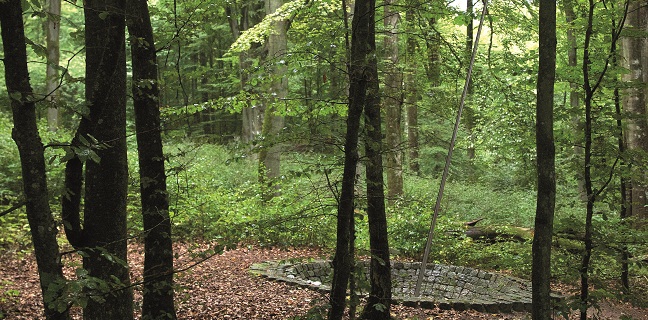
Michael Joo
(Född/Born 1966, verksam i/works in New York)
Mediator, 1998
Aluminium, kullersten, härdat glas/Aluminium, cobblestones, tempered glass
Diameter 250 cm, höjd/height 500 cm
For English please scroll down
Michael Joo deltog i utställningen WANÅS 1998 med det solursliknande verket Mediator. Det är placerat i den östra delen av parken på en höjd dit solen når tidigt på morgonen. Konstverket består av en grop klädd med gatsten. I mitten står en fem meter lång, vertikal aluminiumstav i en hög av krossat glas. Staven är riktad österut och blir för Joo en referens till hans koreanska ursprung. Med Mediator skapar han en plats som pekar ut en riktning och uppmärksammar solens energi.
Samma år som Mediator uppfördes visade Joo en storskalig installation på ett helt våningsplan i Magasinet med titeln Highway. Den bestod av ett enormt träd, som kapades och bars in i byggnaden, för att sedan sammanfogas igen med hjälp av järnstänger. Samma uttryck återkommer i flera av Joos konstverk, han sågar itu och sammanfogar inte bara träd utan också djurhorn. Det styckade trädet är en avbruten process. Från början en del av ett ekosystem, men som separerats både från sin ursprungliga plats och från sig själv, för att sedan sammanfogas så balanserat som möjligt på konstgjord väg.
Joo är både utbildad biolog och konstnär. Hans konstverk kan ses som möten mellan olika världar, mellan naturligt och artificiellt, symmetri och asymmetri, mellan natur, vetenskap och Joos konstnärliga angreppssätt. Joo använder vitt skilda material i sina konstverk, ofta från naturen och han arbetar med allt från performance och video, till skulptur och måleri.
>>>
Michael Joo participated in the exhibition WANÅS 1998 with the work Mediator, which resembles a sundial. It is placed in the eastern section of the park, on a hillock the sun reaches in the early morning. The artwork is comprised of a hollow covered with paving stones. In the middle stands a five-metre-long vertical aluminium pole in a pile of crushed glass. The pole is pointed east and thereby, for Joo, references his Korean heritage. With Mediator, he creates a place that both points out a direction, and brings attention to the sun’s energy.
The same year that Mediator was erected, Joo exhibited the large-scale installation Highway, which occupied an entire floor of the Barn. It consisted of an enormous tree that was cut down and then put together again using iron rods. The same expression recurs in several of Joo’s artworks, but trees aren’t the only thing he saws into pieces and puts back together; he has also used animal horns. The dismembered tree is an interrupted process. It is a part of an ecosystem in the beginning, but it is divorced from not only its original location but also itself, in order to then—as balanced as possible—be put back together artificially.
Joo is trained as both a biologist and an artist. His artworks can be seen as meetings between different worlds, between natural and artificial, symmetry and asymmetry, between nature and science, and Joo’s artistic approach. He uses a wide variety of materials in his artworks, often sourced from nature, and works in areas ranging from performance and video, to sculpture and painting.